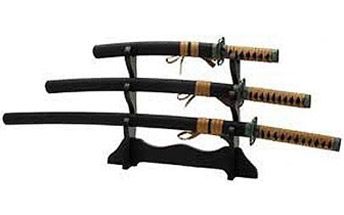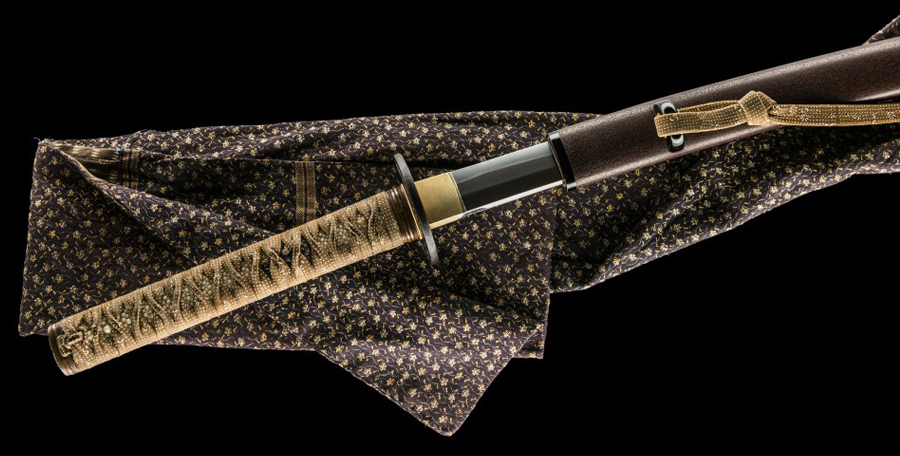Types of Samurai Swords

The combat skills of Samurai are greatly complemented by the strength of the sword they possess. Samurai possessed many different kinds of swords, which went through many changes in their design over the years. Some of these are: chokutu, kodachi, tachi, katana, odachi, wakizashi ,tanto and uchigatana. They all had their own qualities and were used according to the type of duel in which the Samurai engaged. Here are types of Japanese swords below:
- Chokutō (直刀, "straight sword"): A straight single edged sword that was produced prior to the 10th century, and without differential hardening or folding.
- Kodachi (小太刀, "small big sword"): A shorter version of the tachi, but with similar mounts and intended use, mostly found in the 13th century or earlier.
- Tachi (太刀, "big sword"): A sword that is generally longer and more curved than the later katana, with curvature centered from the middle or towards the tang, and often including the tang. Tachi were worn suspended, with the edge downward. The tachi was in vogue before the 15th century.
- Katana (刀, "sword"): A general term for the traditional sword with a curved blade longer than 60 cm (there is no upper length limit but generally they are shorter than 80 cm), worn with the edge upwards in the sash. Developed from the uchigatana and the sword of the samurai class of the Edo period (1600s to late 19th century).
- ōdachi (大太刀, "big big sword")/Nodachi (野太刀, "big field sword"): Very large tachi, some in excess of 100 cm, and usually a blade of the late 14th century.
- Wakizashi (脇差 "companion sword"): A general term for a sword between one and two shaku long (30 cm and 60 cm in modern measurement), predominantly made after 1600. Generally it is the short blade that accompanies a katana in the traditional samurai daisho pairing of swords, but may be worn by classes other than the samurai as a single blade, also worn edge up as the katana.
- Tantō (短刀, "short blade"): It is a type of dagger. The blade is traditionally single or double edged and can range in length between 15 and 30 cm. Usually one-edged, but some were double-edged, though asymmetrical.
- Uchigatana (打刀): A development from the tachi in the 15th century. Worn with the edge upwards in the obi.
Japanese swords are still commonly seen today. Some of the more commonly known types of Japanese swords are the katana, wakizashi, tanto, odachi, and tachi, while the most commonly known type of Japanese sword is the Shinogi-Zukuri katana, which is a single-edged and usually curved longsword traditionally worn by samurai from the 15th century onwards. Here are more details:
Katana is a type of Japanese sword (nihontō), also commonly referred to as a “samurai sword”. The katana sword is characterized by its distinctive appearance: a curved, slender, single edged blade, circular or squared guard, and long grip to accommodate two hands. Most Katana will have a square or round hand guard and the handle will be long enough to accommodate two hands. The blade has long been associated the Samurai class of feudal Japan, it’s instantly recognisable for many due to its appearance in pop culture and it’s synonymous with Japanese swords.
The Katana began its life around 1392-1573, during the Muromachi period. It’s thought the sword came to fruition due to changes to the battlefield environment, which required warriors to be more responsive and faster. The Katana was unique as it was traditionally worn with the edge facing upwards, allowing the wearer to draw the sword and strike there opponent in a single stroke.
The length of the katana’s blade varied considerably during the course of its history. In the late 14th and early 15th centuries, katana blades tended to be between 70 and 73 cm (27.6 and 28.7 inches) in length. During the early 16th century, average length was much closer to 60 cm (23.6 inches), but late in the 16th century, it was again approximately 73 cm (28.7 in). Overall length of our normal size katana is about 40.9 inch (104 cm), nagasa length is about 27.8 inch (70.5 cm). Custom service is also available.
The wakizashi (name meaning is “side insertion”) is a traditional Japanese sword with a shōtō blade between 30 and 60 centimetres (12 and 24 in), with an average of 50 cm (20 in). It is similar to but shorter than a katana, and usually shorter than the kodachi (“small sword”). The wakizashi was usually worn together with the katana by the samurai or swordsmen of feudal Japan. When worn together the pair of swords were called daishō, which translates literally as “large and small”. The katana was often called the sword or the long sword and the wakizashi the companion sword.
The Wakizashi could be used as a backup weapon, or in some circumstances could be wielded in the warriors off-hand, if the Samurai was skilled enough to use two swords at the same time. On occasions the sword may also be used to commit Seppuku, or ritual suicide, which lead to the title ‘Honor Blade’.
When entering a building, a samurai would leave his katana with a servant or page who would then let it rest on a rack called a katana-kake, with the hilt pointing left so that it had to be removed with the left hand, passed to the right, then placed at the samurai’s right, making it difficult to draw quickly, and reducing suspicion. However, the wakizashi would be worn at all times, and therefore, it constituted a side arm for the samurai (similar to a modern soldier’s use of a pistol). A samurai would have worn it from the time he awoke to the time he went to sleep, and slept with it under his pillow. The katana and its partner sword, the wakizashi (sword set)were worn together by the samurai and were items of religious importance as well as symbols of samurai integrity and worth.
The functional Japanese tanto is a Japanese dagger, strictly one with a guard and has all of the fittings used on swords. The Japanese tanto blade rarely exceeds 12 inches in length and usually accompanying a katana. The Japanese tanto is constantly carried and not being left at the door when paying a visit. Japanese tantos were designed primarily as a stabbing instrument, but the edge can be used to slash as well. Medieval Collectibles has many fully functional Japanese tantos that are authentic in detailing and construction.
The Odachi is a large two-handed Japanese sword. Nodachi approximately translates to “field sword”.
Odachi look in many ways similar to a Tachi, however, they are significantly larger and longer.The nodachi was carried by foot soldiers and was designed as a weapon for war versus cavalry and open field engagements. Nodachi were generally used on open battlefields, as their large size made engagement in constricted environments unpractical. They were an effective weapon against cavalry, though they were not commonly used. Foot soldiers would carry the sword with the flat edge against the shoulder and the fuchi, or butt of the tsuka, in the palms of the hands and the blade facing out toward the enemy. The sword would often be thrown down or at the enemy.
Tachi is a Japanese sword, often said to be more curved and slightly longer than the katana. The tachi was used primarily on horseback, where the extra length and curve to the blade made it particularly suited to cutting down any enemy foot soldiers on foot.
The sword is the predecessor to the Katana, as the preferred weapon the of Japan’s warrior class, and it evolved over the years into the later designs. The two are more easily differentiated from each other by the fittings on the blade and how they were worn.
Want a unique sword? Feel free to contact us:
Phone: 086 13739276006
Email: [email protected]
Website: www.hanbonforge.com
Custom Sword Page: www.hanbonforge.com/CUSTOM-SWORDS/Custom-Your-Own-Swords



1 Comment(s)
I'm hoping to find more information on the smallest of the Japanese blades—the one that was traditionally used to commit hara kiri to regain the honor of a family name when a Samurai and/or other soldiers of lesser class were disgraced. I've heard the word for the smallest of swords, which is more of a knife that I believe was traditionally worn tucked into the obi. I see here a reference to Tanto, which in Western knife lore has morphed to indicate a blade shape that's angled at the tip. But that's not the word I read about decades ago as I studied Japanese history. Anyone?
Leave a Comment